Text

I feel like that dril tweet that goes like “I fight capitalism by saying I have never heard of pringles”
#i leave you with my favourite tweet and mindset of all time#young people especially revolt against capitalist desire for personal information/identity data as currency#also i just think this is the funniest tweet ever and i thought you should see it hahaha
100K notes
·
View notes
Text
Digital citizenship, participatory democracy, and misinformation
The internet has allowed the average person’s opinion to be not only heard, but projected, announced, and supported. Anyone has the opportunity to lead a movement or contribute to activism as long as they have access to Internet.
Twitter, infamously known as the political discourse hub of the internet, is largely responsible for this “keyboard warrior” culture. #auspol is one of the most popular tweets of Australian twitter and has remained on trending almost as long as its conception (Bogle, 2016).
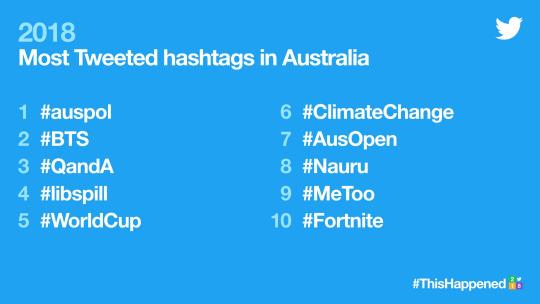
Source: twitter.com
Auspol is part of Australian internet culture. Additionally, a large majority of trending Australian tags are politics related.
#Auspol has revolutionised the Australian citizen as it opens the opportunity for their voice to be heard; their opinion to be amplified. Australian news, such as ABC News, have Twitter engagement and broadcasted trending tweets to publicly notify the discourse.
With so much opportunity and information available, it is not uncommon for the information to be skewed, exaggerated for attention, or simply misinformation -- “fake news”. It is this radicalised information that largely affected the recent revelation that perhaps this free and limitless internet reach is something of the past. With psychographs and metadata of social media profiles holding a large benefit for brands on digital advertising, the Facebook-Cambridge Analytica scandal of 2016 proves it can have dire issues on hindering democracy or the illusion thereof.
As psychographs were proved to have skewed “news” to sway swing voters to Trump’s support (Paul, 2018), the world came to consider that curated content can give the false sense of a public sphere, especially to those who are not fully aware of technology’s knowledge. Further, Facebook’s unchecked power in political control.

Source: https://www.prnewswire.com/news-releases/nearly-half-of-social-media-users-view-facebook-negatively-after-cambridge-analytica-but-many-still-use-the-platform-new-survey-finds-300819164.html
Many Facebook users grew skeptical of the app after hearing its effect in shifting the tides of democracy.
Although internet culture openly allows for public and political discussion in a (mostly) healthy light, recent scandals have caused much of the public to second-guess these perfect opportunities, and whether to declare their political opinion at all.
References:
Bogle, A. (2018). #auspol: The Twitter tag that Australia can't do without, Mashable: https://mashable.com/2016/03/21/twitter-australia-auspol/#4tvfXtsZUEqV
Lewis, Paul; Hilder, Paul ( 2018). "Leaked: Cambridge Analytica's blueprint for Trump victory". The Guardian
0 notes
Text
Five Guys/GamerGate Reference in new Paper Mario
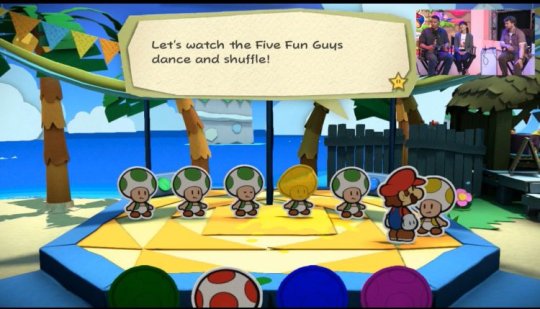

The US localization of the upcoming Paper Mario title has this overt reference to the abuse and harassment Zoe Quinn has been the primary target of over the past two years. It would be tasteless regardless, but that it’s at her expense just makes it all the moreso.
Keep in mind, Nintendo already fired an employee targeted by the same hate group very recently. Their reason for doing so was because they found out about some work on the side she’d been doing, which was acceptable according to their rules, but they took issue with what that work was.
Nintendo has validated the tactics of abusive internet mobs and has basically made an appeal to them with this latest localization decision. They are a company that stands with the misogyny and bigotry that saturates this industry. They are not a company that deserves your money.
If you want to try and do something about this, I recommend using the contact form on their website, specifically corporate social responsibility category.
You can also call customer service at 1-800-255-3700 and ask to speak with that department.
Nintendo of America has a Twitter account you can message. The person running it doesn’t have any control over this stuff but enough attention focused there might force a response from the company.
If you are someone in the games press, I encourage you to contact Nintendo of America and ask them for comment. I also encourage you to write an article about this and why its so awful.
For the time being, although I have little faith in boycotts, I’d encourage people to avoid buying Nintendo products. Be vocal about this decision as well. Encourage friends to avoid buying Nintendo products for now. However, don’t shame or condemn those who don’t participate in this action. That is incredibly important.
Thank you to everyone who has read this. Hopefully this time something of more value will be accomplished.
#ref#another example of a class-action like motion to remove offensive issues#the account i am reblogging from is a tumblr dedicated to submitting posts from anonymous girls that play games and their experiences#it is relevant to my final post where i mention that group anonymity from submitting experiences on accounts helps protect the individuals#by protecting their identity as well as their reputation#week 10
300 notes
·
View notes
Text
JARED CAMPBELL IS THE COP WHO PEPPER SPRAYED THE LITTLE GIRL AND THEN REFUSED TO GIVE HIS BADGE NUMBER. SPREAD THIS MOTHERFUCKER’S NAME.
#ref#doxing of people when they are proven to go against the movement#this is vigilante justice at its peak on tumblr#week 5#week 11
30K notes
·
View notes
Video
Comrades in Minneapolis—this video from Chile shows how to extinguish tear gas canisters quickly, safely, and easily.
To deal with tear gas canisters, take a water jug with a wide mouth, put a little baking soda, dish soap, and/or vegetable oil in the jug of water—3 tablespoons of each to 1 liter of water. Pick up the canister with protective gloves (it’s hot and can burn you!), drop it in the jug, and shake the jug while covering the top with your gloved hand just enough that the gas doesn’t get out. Don’t cover the top too tightly—you don’t want to make the jug explode.
Don’t let the police or #COVID19 cut off your air supply. Fight back!
#icantbreathe #GeorgeFloyd #Minneapolis
#ref#the vocal majority on tumblr are infamously far left as i mention in my first post#during this very recent BLM resurgence there are very popular tumblr posts regarding the specifics on how to protest and effectively
43K notes
·
View notes
Text
Internet Anonymity: Moral Panics and Activism
The convenience, uniquity, easy access and culture the internet created quickly brought upon social resistance (as the law of suppression of radical potential predetermines -- Winston, 1986). Traditional media quickly inflated concerns of the anonymity the internet allowed, as the fear of catfishing and online predators grew. As online interaction continued to become more common amongst the average person, activism and public opinion was often seen, but without necessarily an identity. The #MeToo and #Gamergate controversies have few remarkable people to identify on both sides of their respective movements, but have a very large following. This post will explore the various opinions of internet anonymity and the reaction traditional media followed with.

Anonymous is a “hacktivist” group, known to hack, expose, or simply oppose/defend current issues in the media. For example, the group have exposed members of the KKK and have opposed the Minneapolis Police Department’s actions regarding the very recent George Floyd murder.
Millennial and Gen Z children generally have/had a lot of privacy on the internet: their online history and contacts are not always transparent to their parents. This has resulted to a large fear of online predators. As early as the popularity of AOL or MSN (instant messengers/IMs), there is an abundance of news articles highlighting how the dangers online anonymity can put children at risk. The infamous story of Alicia Kozakiewicz in 2002 sent shockwaves throughout America and internet safety. "Kids need to realize people aren't who they say they are on the Internet," Alicia says (Brueck, 2010). There are a number of online news articles (as well, maybe especially, television coverage) highlighting the dangers of online anonymity and the lack of transparency needed to create fake profiles. Entire television series’ have been successful entirely founded upon this notion, including: Catfish the TV Show, Chris Hansen’s To Catch a Predator, and more recently 90-Day Fiance. These are traditional media shows that have found a following from broadcasting media, whose followings (older generations) may be more sceptical of the internet than the growing non-television watching population (who tend to be younger generations).

Source: https://www.marketingcharts.com/featured-24817
Chart indicating the significant drop of television watchers in youths.
Internet predators as a moral panic has been particularly effective in garnering widespread anxiety amongst parents and older generations as youths’ online communication can be completely unbeknownst to them. Decades after the original wave of concern, the terror of online predators have since subsided as laws were enforced and knowledge grew more universal. Additionally, people began to equate online predators as dangerous and frequent as predators in real-life (Steel, 2009). Hence, the fears of the panic around online predators are generally seen nowadays as uncommon and exaggerated, which is for the most part supported. However, laws such as the Children Internet Protection Act in 2000 or Carly’s Law in 2017 have been made effect specifically due to the public outrage of these isolated issues.
Digital activism has become the heart of many current topics such as: #BlackLivesMatter, #GamerGate, #MeToo, #PrayforParis, #AustraliaFires, #coronavirus, and so on (I go into detail here). However, many people question the battles fought when gaining traction for a post is as easy as making a new account. Rogue Twitter is a phenomenon where people create accounts specifically to share opinions anonymously, and all that is needed is a randomly generated email address and a burner phone (Lee, 2017).

Source: https://theconversation.com/metoo-in-mexico-women-finding-their-voice-as-campaign-gathers-force-114927
There are number of “rogue Twitter” accounts dedicated to submitting anonymous experiences of women on their profiles. This helps hide the identity of women to avoid any potential backlash from speaking out (dismissing the point that their confession is “for attention”), as well as allowing for a support system or “class action” like follower base.
Although there are a lot of fears regarding the legitimacy of digital anonymity and the potential of spreading misinformation, it is protected in America by the First Amendment. That said, it has caused social dangers in many movements. For instance, “Gendertrolling”, a term used by Karla Mantilla, is used to explain the misogyny and harassment women face for declaring their opinions online in subcommunities where their voice is not nearly a majority (Mantilla, 2015)(I go into detail on this topic here). “Slut-shaming, gaslighting, dismissal, fallacious logic, and intimidation” are all apparent common tools used by the opposing following regarding #Gamergate and #MeToo movements when surrounding women announcing their experiences (Mantilla, 2015). This can go both ways. While many who oppose and attack women on these issues could be anonymous to avoid backlash, it is found that the women speaking also fear being attacked (shown in the picture above). This is particularly the case in countries with a strong culture of dismissing women’s experiences or condemning them to silence, such as Mexico (Shaw, 2019). Thus, people addressing issues on either side are afraid on online backlash due to anonymity, but ironically are also protected by it.

Source: twitter.com
#WeMetOnTwitter was a trend of people sharing their online relationship stories and the successes as a result.
Opaque identity on the internet has always caused uncertainties, fears, and curiosity. However, the voice of the otherwise silent, oppressed, or afraid, are given the opportunity to speak up. Many positive relationships have grown from what was originally anonymous and unclear (as seen above), though it should not be neglected that there are unsavoury occurrences as well.
Online vocality is perhaps more apparent than in real-life, but the growing vocal population are proving to be more and more aware of the difficult nature of the internet, yet the easy procedure to create “rogue Twitters”.
Conclusively, digital debates, profiles, and predators are not necessarily very different from the traditional parallels. A Twitter username might be as memorable as the face of a bickering debater in-person, and the traits needed to identify online predators mirror those of a physical one. Though we face new tools and new means of communication, human behaviour has always been the innate force of any cultural factor.
References:
Brueck D, 2010, Survivor of Internet Predator to Share Story, NBC News 15: https://www.nbc15.com/home/headlines/Survivor_of_Internet_Predator_to_Share_Story_104795524.html
Lee, M. 2017, How to Run a Rogue Government Twitter Account with an Anonymous Email Address and a Burner Phone:
Shaw, D. 2019, #MeToo in Mexico: Women Finding Their Voice as Campaign Gathers Force: https://theconversation.com/metoo-in-mexico-women-finding-their-voice-as-campaign-gathers-force-114927
Steel, E. 2009, No Easy Answer for Protecting Kids Online, Wall Street Journal: https://www.wsj.com/articles/SB123187498732078111?mod=searchresults&page=1&pos=19
Winston, B 1986, Misunderstanding Media, Taylor & Francis Group, Milton.
0 notes
Photo


If you haven’t already seen, EA now have the most downvoted comment (almost half a million) in Reddit history due to this shitty response, making sure we don’t forget how horrible they are (link)
#ref#the reddit gaming subreddit is one of the most popular subreddits on the platform#reddit is seen to themselves and others as the gamer social media platform (generally speaking)#the most downvoted comment to date is EA's response about their microtransactions and the pay to win features on star wars battlefront 2#public opinion of EA is infamously bad#for several years in a row EA has scored the worst company in america#week 10
4K notes
·
View notes
Text
Gamer Sub-Communities: MMO Guilds, Steam, and GamerGate
With the digital presence many videogames require, it is only natural to hold such a strong online social media presence and community as a result.
As videogames grew more multiplayer based and encouraged social interaction with others online, many communities developed. MMORPGs (or MMOs - not MM lol) were renowned for the guilds, servers, and GM events that were structured to make the game environment feel more like a town-square than simply an arena. Thus, MMORPGs and their playability are purely incentivised by social interactivity and the community a player will find themselves in. Games like World of Warcraft, Guild Wars 2, TERA, and more recently Black Desert Online have been fundamentally designed to prioritise community. Though this can motivate and cultivate long friendships, it means the games tend to have a quick expiry. (Duchenaut et al, 2007). User inactivity of someone important to another user (whether that user is a guild leader, or game moderator, or someone dear to them), tends to be contagious. TERA, for instance, reduced the importance of grinding, or repetitive gameplay, significantly (compared to other MMORPGS) to level up to the max level (level 60 upon release). This allowed players to focus on PvP (person vs person) instead of PvE (person vs enemy/mob), thus inciting mass player participation with one another. It also allowed them to focus on guild raids (massive groups of guilds colliding with one another). However, this produced a game that was extremely dependent on social activity: if many people play the same MMO, it thrives, but if no one is playing it, the game dies off (Duchenaut et al, 2007). The game quickly died off as social incentive reduced almost immediately.
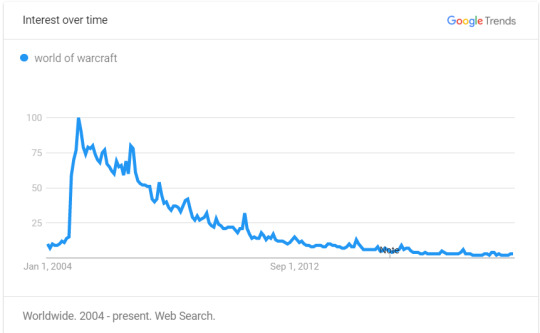
Source: google.com
MMOs are a genre that do not last due to the social unity it requires compared to other game genre.
Many videogame applications evolved to becoming a “gamer” social media platform. Steam, originally a Valve video game launcher, slowly improved their mechanics to introduce forums, groups, galleries, reviews, and voice/message chats. Steam reviews of videogames tend to be purely public opinion and available for anyone to read and to write. As a result, many popular reviews do not have to be well-written and detailed, but could hold more value as a community inside joke, or even a meme. Funny reviews, however, have been argued to be more like a culture to Steam reviews, and are there for the sake of community rather than for games and the average man’s critique (Ebelhard et al, 2018) .
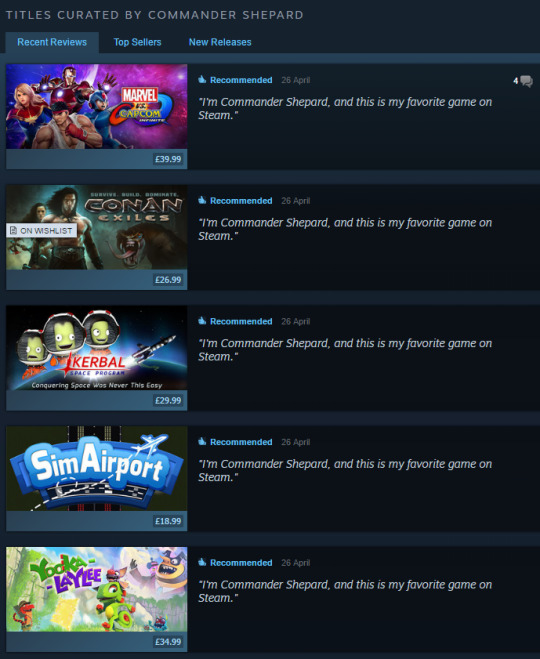
“Commander Shepard”, a Steam User, is entirely dedicated to recommending Steam Games with “this is my favorite game on Steam”. It has become its own internet/Steam sensation and is found on many well-known games (not necessarily good). This is a reference to Commander Shepard in Mass Effect 2 when asked to promote several shops with “I’m Commander Shepard, and this is my favourite store in the Citadel.”
Source: https://imgur.com/gallery/yG7Ux
With many gaming subcommunities and its growing ubiquity, gaming communities have been known to face conflict. #GamerGate was a hashtag acitivism with no real leader or manifesto, though it is described as a culture war regarding the social values videogames represent (Ip, 2014). The vocal majority in videogame communities are seen as male, and thus, much of the GamerGate controversies have been summarised as conservative backlash against female progressivism in the gaming community (Kidd, 2016). On the other hand, many also believed that the misogyny angle was generally pandering and oversimplifying an issue regarding journalistic integrity. Women on both sides were also frustrated that the spotlighted vocal minority of females: Anita Sarkeesian and the like who are caricatured “raging-feminists” which did not accurately represent the women in the videogame community, but worsened the image of women in the community.

The current like/dislike ratio of a Late Night Show interview with Anita Sarkeesian. She is seen as a hyper-feminist amongst gaming communities. The biased angle of the infamously “out-of-touch” Late Night Talk Show (in terms of internet culture) on a sensitive topic like GamerGate resulted in extreme backlash and further worsened the situation (especially in regards to broadcast/journalistic integrity). The video is unavailable in many countries and comments have been turned off.
The backlash very quickly turned to threats, doxing, and humiliation upon certain women in question, and then eventually evolved into any woman speaking out about the controversy, or in the videogame community in general. However, many argue that the issue was rejecting valid criticism as misogyny, rather than misogyny itself. Since there are so many accounts and experiences regarding GamerGate as it is such a vague and vast hastag and movement, it can not be easily explained as to what the movement fundamentally believed in. The result however, is well-known as a “misogynistic mess”, and “the perfect shitstorm” as a result of the largely male voice in the videogame community (Dean, 2014). Once GamerGate subsided, many men and women exclaimed the broadness, sensitivity, and bias of the controversy to have negative repercussions and skewed narratives on both sides: there are no winners with GamerGate.
References:
Dean, T. 2014. A balanced view of GamerGate. ABC News: https://www.abc.net.au/technology/articles/2014/10/28/4116140.htm
Ducheneaut, N., Yee, N., Nickell, E., & Moore, R. 2007. The life and death of online gaming communities: a look at guilds in world of warcraft. In Proceedings of the SIGCHI Conference on Human Factors in Computing Systems (CHI ’07). Association for Computing Machinery, New York, NY, USA, 839–848. DOI:https://doi.org/10.1145/1240624.1240750
Eberhard L., Kasper P.,Koncar P. and Gütl C., "Investigating Helpfulness of Video Game Reviews on the Steam Platform," 2018 Fifth International Conference on Social Networks Analysis, Management and Security (SNAMS), Valencia, 2018, pp. 43-50, doi: 10.1109/SNAMS.2018.8554542.
Kidd, D.; Turner, Amanda J. (2016). "The #GamerGate Files: Misogyny in the Media". In Novak, Alison; El-Burki, Imaani J. (eds.). Defining Identity and the Changing Scope of Culture in the Digital Age. Hershey, Penn.: IGI Global. p. 122. ISBN 978-1-52-250212-8.
Ip, C. 2014. "How do we know what we know about #Gamergate?". Columbia Journalism Review.
1 note
·
View note
Photo
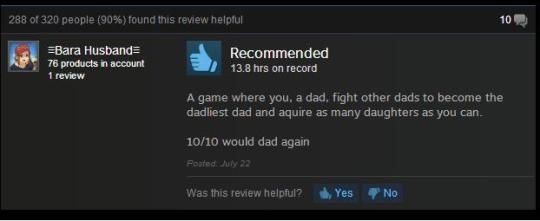
My favorite BioShock 2 review
#ref#an example of how funny reviews are seen as helpful to other people when they dont actually offer any videogame criticism#there is a sense of community and incentive to write reviews others support#or at least are humored by#week 10
35K notes
·
View notes
Text
Tumblr’s tagging is such a valuable social media tool, because it offers an…indoor voice. A way to talk on content without throwing a rock through the creator’s window.
#ref#just an explanation for why i speak in tags#i dont want to throw a rock through the op's window#also i think its appropriate in this subject to conform to the standards of the social media platform we use
54K notes
·
View notes
Photo
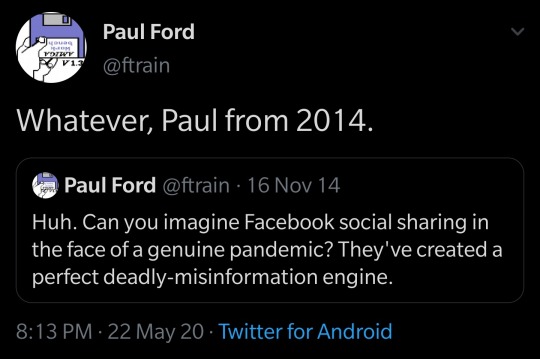
#reference#we see here that twitter is used a public discussion platform to call out other platforms and sometimes twitter itself#facebook is infamously perceived as a deadly misinformation engine#we can extend this by understanding how twitter is more open to a discussion when politics is on hand#facebook on the other hand is seen as the perfect fake news platform#week 9
68K notes
·
View notes
Text
Facebook vs. Twitter: Varying effectiveness for political activism
We are all aware of the varying potential every social media platform has in terms of media and engagement, but they also cultivate different political engagement and potential for activism. This submission will look at the differences and impacts a political/opinion-piece can have on different platforms. The platforms explored will be Facebook and Twitter: similar “old” age group as well as their social media lifespan, but their differing functions and features of the platforms as programs allow for a varying projection of opinion.
The majority of the world recognises Facebook’s universal reach and power in the digital landscape, though it is important to acknowledge where it falls short to fully grasp whose opinions are projected here.
Facebook and Twitter are perhaps the “oldest” platforms – not just in its archaic lifespan in terms of Internet age, but also in its audience. This has repelled many youths worldwide from using them as communication. Facebook for instance, is used for younger people like a social-circle version of a “LinkedIn” profile (a social portfolio). This is extremely apparent in Indonesia, where only “old people use Facebook”: youths only access the platform occasionally to check up on loved ones (Raslan, 2019). Thus, the vocal majority of opinions on Facebook tend to be 35 years of age or older.

Younger age groups tend to be more self-conscious with how they present themselves online, especially to peers. As a result, there is a significant “spiral of silence” on the platform, where young Facebook users are afraid to show differing opinions in fear of instigating drama (Liu et al, 2017). This could also be attributed to “cancel culture” and the intense backlash over opinions or statements made that may be somewhat controversial (Cutsinger, 2019).
Facebook fundamentally operates around social circles and what people share to their peers. As a result, most opinion pieces, activism attempts, or political promotion are often only seen by the circle created by the original poster. Though it is possible to share posts, often the “spiral of silence” and its power grasps Facebook users strongly. Older generations, unlikely aware of this culture and indifferent to online judgement, tend to ignore this and often share anything their mind sees fit.
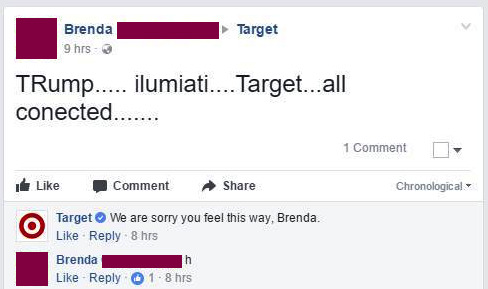
Source: https://www.reddit.com/r/oldpeoplefacebook
Twitter has a completely different landscape, with a very similar audience. As opposed to Facebook, Twitter does not rely on the social circles of its users, and depending on the hashtags or people tagged, a post can gain traction purely from popular trends. Due to its more public nature and the easy potential to have popular posts without a necessarily strong following (Foucault Welles PhD, B., 2019), many have clamoured to the desire of being heard from their opinions. As a result, there is a very progressive and vocal Twitter environment and has famed the platform for being exclusively for democratic political activism, called Hashtag activism.

Source: twitter.com - Current trends on Twitter
Movements produced from Twitter have been very influential, some being the #MeToo movement, #BlackLivesMatter, #PrayforParis, and #ALS. Although it may not be directly impactful on the subject at hand, hashtag activism is very powerful in global exposure (Hahn, 2016). Unscathed from political or commercial bias, Twitter has no broadcasting favouritism. Thus, many movements stemmed from hashtag activism have been perhaps initiated online due to traditional media controlling the narrative.
Holistically, we can ascertain that Twitter has a significantly stronger projection and power in regard to activism. It is responsible for the majority of digital movements and political exposure and allows for public voice to be equal for all its users. Unlike other media platforms like YouTube or Facebook, Twitter has not been accused of distorting public opinion on their platform and is perhaps purer in its display of democracy. Thus, the platform remains the best in vocalising activism and political engagement.
References
Alvarez N., Lauzon C., Zaiontz K. (2019) 'On Sustainable Tools for Precarious Times: An Introduction'. In: Alvarez N., Lauzon C., Zaiontz K. (eds) Sustainable Tools for Precarious Times. Contemporary Performance InterActions. Palgrave Macmillan
Carr, David (2012-03-25). "Hashtag Activism, and Its Limits". The New York Times. NYtimes
Cutsinger, R. 2019. Cancel ‘Cancel Culture’ , Carlsbad.
Foucault Welles PhD, B. 2019, Researching online activism using social network analysis, SAGE Publications Ltd, London,
Hahn, Allison. "Hashtag Activism". 2016. Salem Press Encyclopedia.
McCarthy, N., 2019. Is Facebook Becoming Social Media's Retirement Home? [Infographic]. [online] Forbes. Available at: <https://www.forbes.com/sites/niallmccarthy/2019/03/08/is-facebook-becoming-social-medias-retirement-home-infographic/#152c57341ba9>
Noelle-Neumann, E. (1977), "Turbulences in the climate of opinion: Methodological applications of the spiral of silence theory", Public Opinion Quarterly, 41 (2): 143–58, doi:10.1086/268371
Raslan, K., 2019. Why Facebook Faces The Myspace Graveyard In Asia. [online] South China Morning Post. Available at: <https://www.scmp.com/week-asia/opinion/article/2182212/facebook-faces-myspace-graveyard-asia-line-instagram-and-twitter>
0 notes
Text
Body Image and Social Media
The digital age has allowed the first-world to have a plethora of tools and media at its disposal. In terms of health, the Internet has helped spread the importance of many positive messages, including maintaining good mental health, ALS awareness, and emphasising the need to stay home throughout COVID-19. It has also been used to help developing countries and assist them in aiding those they may not be completely educated about, for instance, burn victims (Thompson, 2016). Though it can grant us limitless amounts of entertainment and education, it can also prove to be harming to the way we perceive ourselves. With immensely popular and quickly-consumed/"hot media” method of Instagram, we see this phenomenon grow largely out of proportion. From “playful” story filters to heavily manipulated images, Instagram knows no bounds as to what content is universally/morally healthy for the sake of aestheticism.
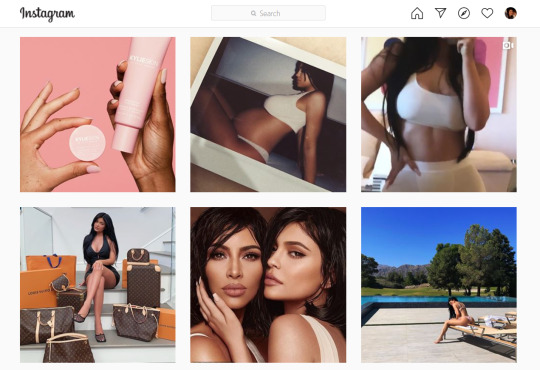
@kyliejenner’s IG feed. Jenner is the 6th most followed IG account, with 7 of the most liked posts on the entire platform.
Influencers are the lifeblood of Instagram content and advertisement opportunity. Such marketing is expected to surpass $9.73B USD in 2020, and 91% of participants believing influencer marketing to be an effective form of sponsorship (Influencer Marketing, 2020). Largely preying on the impressionable and young fashion/beauty community, influencers and advertisers tend to be most successful when promoting brands towards personal image and style, and further, users comparing themselves to the influencer.
There is significant research that suggests that women are vastly dissatisfied when viewing attractive strangers on Instagram (Meikel, 2013), thus potentially implying that there is an intention to subconsciously drive viewers to shame and self-consciousness with excessive body distortion and representation in the hopes that it will be profitable.
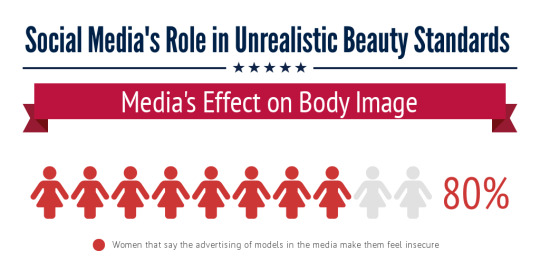
Source: https://infogram.com/social-medias-role-in-unrealistic-beauty-standards-1gk92evxz1qrp16
However, there is also research that indicates that celebrity imagery is not entirely at fault: unknown peers are found to make women feel worse about their own appearance as much as celebrity pictures do (Brown et al, 2016). This suggests that the overall repetitive imagery of glamorous women and unrealistic standards of feminine beauty deliver the same attitudes, regardless of the content creator’s status. It is the atmosphere, however, that social media platforms cultivate.
Another important body-image issue is Tumblr and the dangers of subcommunities in this regard. The “pro-anorexia” or “proana” community is a prevalent and infamous subcommunity on Tumblr that is known for anorexia glorifying, and the aesthetic of extremely underweight people for the sake of appearing more “grunge”. In other words, the subcommunity enacts an anorexia lifestyle, where many within it can endorse, support, and maintain their anorexia (De Choudhury, 2015). Aligned with an “edgy” “punk”, and “grunge” vibe, there is significantly negative and triggering connotations when looking at “proana” posts and their surrounding content.

The “proana” tag on Tumblr 10.5.20
Perhaps Tumblr’s isolation through the blogs and tags followed curates the content needed to cultivate such a reinforced behaviour on a negative and serious disorder, especially considering 80.9% of tags under “proana” related content are found exclusively in this section of Tumblr (De Choudhury, 2015). This suggests that those who seek these posts tend to identify with the group or the aesthetic/glorification.

Source: De Choudhury, 2015 - Anorexia on Tumblr: A Characterization Study.
The power and potential of social media is a double-edged sword: Though it enables the health and education of many, much of the first-world suffers as it attempts to pinpoint a fundamentally cruel concept of human perfection.
References:
Brown, Z. and Tiggemann, M., 2016. Attractive celebrity and peer images on Instagram: Effect on women's mood and body image. Body Image, 19, pp.37-43.
De Choudhury, M. Anorexia on Tumblr: A characterization study (2015). ACM International Conference Proceeding Series, May - 2015 , pp. 43-50.
Influencer Marketing Hub, 2020. The State Of Influencer Marketing 2020: Benchmark Report: https://influencermarketinghub.com/influencer-marketing-benchmark-report-2020/
Meikle, J, 2013. Growing number of girls suffer low self-esteem, says report. The Guardian: https://www.theguardian.com/society/2013/nov/29/girls-low-self-esteem-rising-girlguiding-report
Thompson, S 2016, 'How social media is transforming medical care in the developing world' Fast Company.
0 notes
Text
Slow-Fashion and Instagram’s Influence
The Rana Plaza disaster in 2013 saw the death of over 1,100 poverty-stricken Bangladeshi fast-fashion garment manufacturers who had been working under extremely poor conditions (Padmanabhan et al, 2015). Since then, there has been significant pressure on the fashion industry to become more environmentally sustainable and conscious. With the rise of the digital age and participatory culture, consumers have grown more “woke” of the clothing they choose to purchase (Amed et al., 2019). This has been accelerated by the social influence on aesthetically-charged social media platforms like Tumblr or Facebook, but predominantly from Instagram.
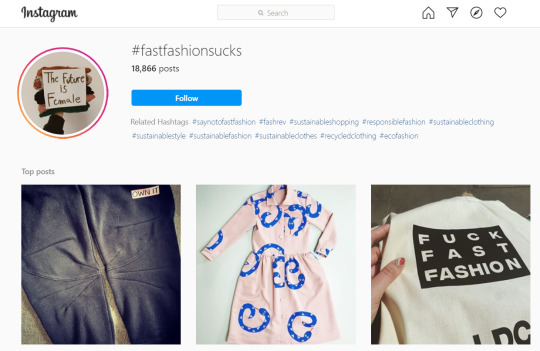
Instagram has a large beauty and fashion community: any relevant fashion brand will have a social media presence, especially an Instagram account (Ahmed, 2019). Combined with both the rise of consumer knowledge and aesthetic lust on Instagram, the social media has found themselves in the sights of a strong environmental push on fashion and the drive for consumers to influence and be influenced by a slow-fashion movement. There are a multitude of methods influencers use to push these agendas. This piece will focus on two genre of Instagram environmentally charged fashion trends: the indirect pressure of aesthetic posts, and the more direct “call-out” posts.
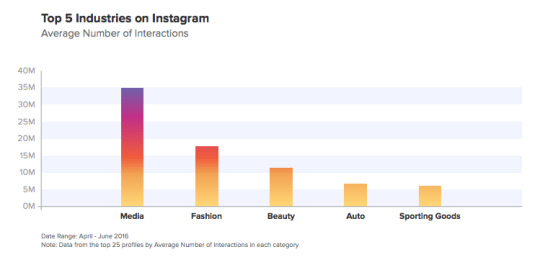
Source: https://growthlab.com/instagram-marketing-for-entrepreneurs/
Aesthetic posts are perhaps less agenda driven, but have a larger influence on fashion trends, primarily through second-hand “vintage”. From the grungy Instagram film hipsters such as @nicolealyseee (owner of genuine vintage clothing store) to the boho hippie mum @tuulavintage (Bohemian aesthetic blogger), viewers are subconsciously influenced by the style and fashion of the Internet-popular. Despite the subcultures created by social media platforms, there is a common characteristic of all fashion aesthetics: expensive clothing, repeated outfits, and the individuality and glory of finding a good thift store bargain (Bereznak, 2017). Instagram has thus propelled the second-hand e-commerce aspect significantly due to consumers and their freedom and desire to find an edge in their aesthetics.

Source: @luanna https://www.instagram.com/p/B0OCe5JFhi-/ : A grungy and alternative aesthetic influences fans by seeking a genuine good fashion find for themselves as opposed to the “cheap” look of fast-fashion.
Perhaps more ethically steered and with more pressure upon the fashion industry are “call-out” accounts. These are Instagrams dedicated to scrutinising well-known fashion brands with their environmental or social ethics. With a large following, call-out accounts can influence boycott of large designer brands. This is the case with DKNY, Victoria’s Secret, and many top retailers whose shares have been struck a blow amongst their (former) Millennial/ Gen Z fans (Katebi, H. 2014). Instagrams such as @dietprada and @thefashionlaw are strong influencers who are primarily driven to inform their fans of corporations’ actions behind the scenes and hold brands accountable for their wrongdoings.

Source: @thefashionlaw : https://www.instagram.com/p/B3CjQYSFrLx/? : The Fashion Law informs their viewers on the fashion industry. Example here is that the fast-fashion pioneer Forever 21 has filed for bankruptcy as a result of fast-fashion boycotting.

Source: @dietprada : https://www.instagram.com/p/B5-onrmnd3s/ : Similar to the above reference, dietprada is another call-out blog with perhaps more of a focus on opinionated Instagram pieces. Here, a fast-fashion retailer imitates a signature Versace gown, by which dietprada addresses “Fashion Nova”‘s continued mimickery of luxury fashion brands for a significantly cheaper price.
As the power of broadcast culture diminishes and as consumers transform “from voyeurs to participants” (Levinson, 1999), democracy in brand management and ethics grows ever more crucial and necessary. As Instagram continues to expand and hold power over aesthetics, trends, and the power to “cancel” entire retailers, brands are pressured now more than ever to transition into the trend of slow-fashion and maintain a circular economy (Claudia et al., 2017) for the betterment of the future.
References:
Ahmed, O. (2019)
How Instagram Transformed the Fashion Industry.
[online] Vice. Available at: https://i-d.vice.com/en_au/article/bj9nkz/how-instagram-transformed-the-fashion-industry;
Amed, I., Balchandai, A., Beltrami, M., Hedrich, S. and Rolkesn, F. (2019).
The influence of ‘woke’ consumers on fashion.
[online] McKinsey & Company. Available at: https://www.mckinsey.com/industries/retail/our-insights/the-influence-of-woke-consumers-on-fashion;Bereznak, A. (2017).
Instagram and the Art of the Thrift Store Find.
The Ringer. Available at: <https://www.theringer.com/2017/5/11/16041208/instagram-vintage-thrift-store-clothing-b5d12a8cf3b5>; Claudia E. Henninger, Daniella Ryding, Panayiota J. Alevizou and Helen Goworek,
‘Introduction’ Sustainability in Fashion A Cradle to Upcycle Approach,
edited by Henninger, C.E., Alevizou, P., Goworek, H., Ryding, D. (Palgrave: 2017);
Katebi, H. (2014 - present: ongoing updates)
BOYCOTT LIST.
Joojoo Azad
: <
http://www.joojooazad.com/p/boycott-list.html?m=1>;
Padmanabhan, V., Baumann-Pauly, D. and Labowitz, S. (2015).
The Hidden Price of Low Cost: Subcontracting In Bangladesh’s Garment Industry.
[online] Available at: https://poseidon01.ssrn.com/delivery.php?ID=552114115001089019012097122021089027046082018033091033077096123073113090107114094005034102023059043112038104080014104084094080053021092039027004081005006123107088004069013011124022087099086078099000081071025003020022088126107124092102072011068086126068&EXT=pdf;Nicole Alyse, Instagram: <
https://www.instagram.com/nicolealyseee/
>;
Jessica Stein, Instagram: <https://www.instagram.com/tuulavintage
/
>;
0 notes
Photo

Anyways shopping is exhausting
276 notes
·
View notes
Photo
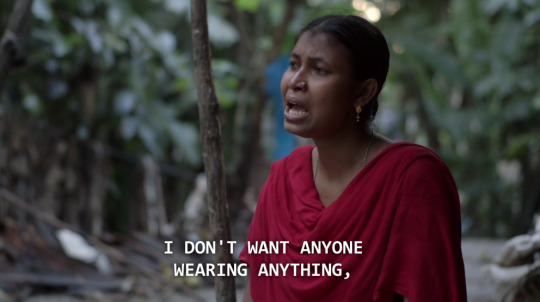
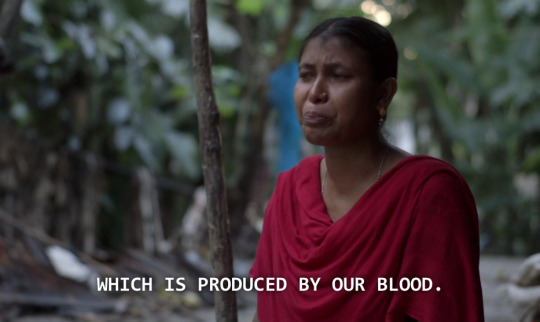


your $5.80 Forever 21 t-shirt comes at a human price
1000s of sweatshop workers are killed each year
Fashion is the second most polluting industry in the world, after petroleum
reduce, reuse, recycle - ask how your clothing is made
Credit: “The True Cost” documentary, now on Netflix
#reference#public knowledge of coporate activity continues to expand and grow ever more topical and common#important to put pressure on the world for ethics#week 7
13K notes
·
View notes
Text
Dean holds a large emphasis on the positives Tumblr harnesses through its desire to develop and cherish its communities with the platform’s various unique features. I think this is an accurate stance many took in Tumblr’s glory days, but can now be seen as somewhat romanticised. I think, due to the large loss in traffic as a result of fundamental site changes for the sake of profit, Tumblr has forsaken the majority of its users. It does not cherish the community as much as its users do, and thus the remaining users cling to what remains of their cliques.
How does Tumblr function as a digital community?
Where to start!
Tumblr is an online micro-blogging and social networking platform founded by David Karp in 2007. This is the fancy way of saying a social media platform designed for anonymous or authored content sharing; predominantly text and images in an aesthetic manner. Much like the public sphere, Tumblr acts as a place where private (and non-private) people come together as a public for the purpose of using reason to further critical knowledge (Kruse, Norris & Flinchum 2017).
The social media site has an inherently addictive element to it that makes one want to scroll endlessly in the vast stream on content, and the flipside to viewing content, is to post it. The need and desire for sharing and co-experiencing content (Siapera 2012) is so strong and I think this is what has attracted the attention of the millions of users post regularly.
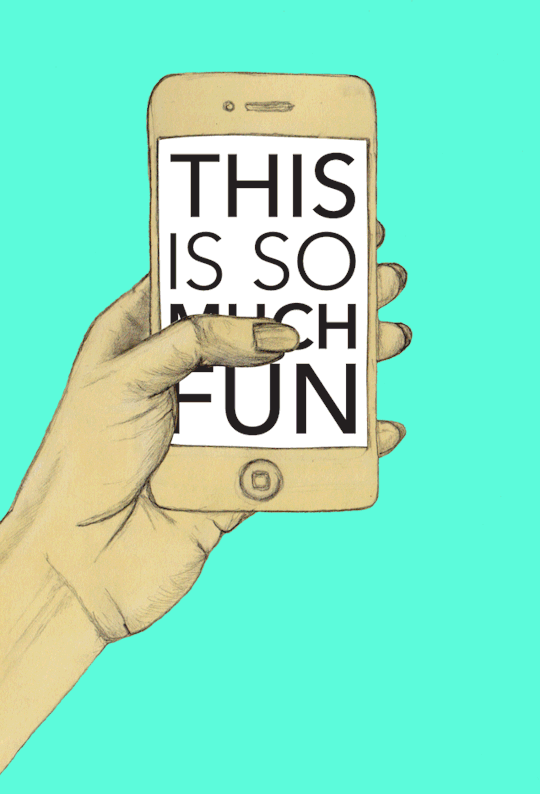
These users, identifying as millennials (Heine, 2015; Smith, 2017) come to Tumblr to congregate and share content whether it be informative, artistic, intended to challenge the status quo or with the goal being to garner a laugh. By nature, we are curious, social and want to understand and interact (Mandiberg 2012), therefore the want to come together as a digital community is instilled in us from birth.
Tumblr supports this notion as a platform, it relies on the calculated (or artistically not calculated) deployment of one’s digital self-representation (Scolere, Pruchniewska & Duffy 2018) and thrives as its many users curate and stylise their own section of the site. Although visual and textual content such as images and other material is spread rapidly each day, it is still important to understand the tone of the platform and constrain to using it for it is best for; reblogging and quick moving content (Keller 2019).
I think ultimately, the vast differences act as a positive on Tumblr as anyone is able to access the site and find something that interests and resonates with them. Much like a real life town where there’s anything and everything – a digital community if you will.
References
Heine, C. (2015, December 16). Here are the top 25 Tumblr posts sponsored by brands in 2015. Adweek. Retrieved from http:// www.adweek.com/digital/here-are-top-25-tumblr-posts-spon- sored-brands-2015-168653/
Keller, J 2019, ““Oh, She’s a Tumblr Feminist”: Exploring the Platform Vernacular of Girls’ Social Media Feminisms”, Social Media + Society, vol. 5, no. 3, p. 205630511986744.
Kruse, L, Norris, D & Flinchum, J 2017, “Social Media as a Public Sphere? Politics on Social Media”, The Sociological Quarterly, vol. 59, no. 1, pp. 62-84.
Mandiberg, M 2012, The Social Media Reader, New York University Press, New York. Available from: ProQuest Ebook Central. [22 April 2020].
Scolere, L, Pruchniewska, U & Duffy, B 2018, “Constructing the Platform-Specific Self-Brand: The Labor of Social Media Promotion”, Social Media + Society, vol. 4, no. 3, p. 205630511878476.
Siapera, E 2012, Understanding new media, Sage, Los Angeles.
Smith, C. (2017). 96 amazing Tumblr stats. Retrieved from http:// expandedramblings.com/index.php/tumblr-user-stats-fact/
Tumblr, 2019, ‘About’, Tumblr. [online] Available at: < https://www.tumblr.com/about> [Accessed 26 April 2020].
21 notes
·
View notes